In Ecuador, this dish is called hornado de pierna de chancho and it’s made with a whole pork leg. You make this roasted pork leg by letting the pork soak in a sauce made of beer, orange juice or cider, garlic, achiote (annatto), and spices. It is then slow roasted with butter and spices.
For people in Ecuador, hornado is a traditional roasted pork dish that is often sold at food stands in local markets. Most of these places will roast the whole pig in a large outdoor clay oven. In the traditional way, lard is used instead of butter and chicha, a drink made from fermented corn, is used instead of beer. Since chicha tastes like dry apple cider, I’ve started marinating the meat in a mixture of beer, cider, and orange juice.
I usually make pork hornado a few times a year, especially for Christmas/New Year. It’s not always a 20-pound pork leg that I cook. Most of the time, it’s a smaller pork shoulder or butt. I’ve adapted that recipe for smaller cuts/less marinating/quicker cooking. If you want to do the whole leg, you’ll probably find them at a butcher’s shop instead of a main grocery store. I also find them at the Asian supermarket near me. If you need them, either one will order them for you with a week’s notice, which is especially helpful during the holidays.
Spanish hornado can be bought at most markets all year, but it’s more common to prepare it ahead of time for holidays or special events. It is impossible to serve this roasted pork dish by itself. The side dishes are a very important part (and this is true for many Ecuadorian dishes). I can’t imagine eating hornado without tasting the mote (hominy) or curtido or avocado in the same bite.
There are many side dishes to choose from, and they will be different from one place to another or from restaurant to restaurant. The sides also depend on each person’s personal preferences (and the ingredients and time you have available). Since the pork is roasted in beer and butter, it will leave lot of juices in roasting pan. During the last few hours, I love adding whole potatoes. They taste great and get very tender because they cook in the pork sauce.
This recipe is time-consuming as the pork leg needs to marinate for two-three days. While marinating for a day or two hours is the best way to make it, this is the best way to make sure that all the flavors get into the meat. To make hornado faster, I have another recipe for a smaller piece of meat that can be cooked in less time.
A whole pork leg can seem intimidating to cook. Also known as a fresh ham or pork hind leg, this large cut of meat requires some preparation and skill to transform into a tasty meal. However, with the right techniques, a whole pork leg can become the centerpiece of an impressive dinner or gathering. This article will explore different cooking methods, flavorings, and serving suggestions to make the most of a whole pork leg.
Overview of a Pork Leg
-
Weighs 8-12 pounds
-
The leg or hindquarter of the pig
-
Contains a bone-in thigh and shank
-
Well-marbled with fat and connective tissue
-
Benefits from slow, moist cooking methods
-
Can be roasted, braised, grilled or smoked
-
Provides plenty of meat for a crowd
A whole pork leg has endless possibilities. With the bone in and skin on, it can produce succulent meat, crispy crackling, and rich pan drippings for gravy. While beef roasts may be more common, pork legs have their own unique flair. Let’s look at preparation and cooking techniques.
Preparing a Pork Leg for Cooking
Proper prep is key to a juicy, flavorful finished pork leg. Here are some tips:
-
Score the skin and fat cap in a criss-cross pattern
-
Season well under the skin, over the meat, and on the bone
-
Refrigerate uncovered to dry out the skin for crisping
-
Marinate overnight for more seasoning penetration
-
Let come to room temperature before cooking
-
Tie up with butcher’s twine to maintain shape
Take time to dry out the skin, create scores, and season everywhere. This sets up the pork leg for full flavor development and textural contrast.
Best Cooking Methods for a Pork Leg
There are several excellent options for cooking a whole pork leg:
Roast in the Oven
-
Cook at high heat to crisp skin then reduce temperature
-
Allow 20-30 minutes per pound to reach 145°F internally
-
Baste and tent with foil to prevent over-browning
Braise on the Stovetop
-
Brown pork leg then simmer in liquid for tenderness
-
Use broth, wine, or cider to create delicious braising liquid
Grill Over Charcoal or Wood
-
Go low and slow near indirect heat
-
Add smoke flavor with wood chips or chunks
-
Rotate and flip frequently
-
Finish over direct heat to crisp skin
Smoke Low and Slow
-
Keep temperatures between 225-250°F
-
Use wood chips, chunks or logs for smoky flavor
-
Cook to internal temp of 145°F with sweet, spicy rub
Each method produces delicious results. Roast for ease, braise for falling-off-the-bone meat, grill for char, and smoke for incredible depth of flavor.
Herbs, Spices and Flavors for Pork Leg
Pork pairs well with a wide range of seasonings. Consider:
-
Herbs – rosemary, thyme, sage, oregano, marjoram
-
Warm spices – garlic, onion, mustard, coriander, cumin, chili
-
Sweet flavors – brown sugar, maple, honey, apples, peaches
-
Savory flavors – soy sauce, Worcestershire, balsamic, mushrooms, charred onions
-
Acidity – citrus, vinegar, wine
Experiment with wet and dry rubs, marinades, and glazes. The pork leg’s high fat content allows it to absorb flavors beautifully.
Serving Suggestions for Pork Leg
A whole roasted pork leg is extremely versatile. Here are some delicious ways to serve it:
-
Carve into boneless slices for plated entrees
-
Pull into shredded pork for sandwiches
-
Chop into chunks for stews, pasta, or tacos
-
Pair with roasted vegetables, creamy mashed potatoes, fresh salad, or spicy beans
-
Make stock from the bone for bean, greens, or grain dishes
-
Use extra crackling as a garnish for salads and soups
-
Turn pan drippings into gravy or sauce
A little creativity turns a pork leg into several easy, tasty meals. The possibilities are endless!
Step-By-Step Instructions for Roast Pork Leg
Follow these simple steps for a showstopping roast pork leg:
Prep (Night Before):
- Score skin and fat cap
- Season all over with salt, pepper, garlic
- Refrigerate uncovered overnight
Roast Day:
- Remove pork from fridge and let sit until room temperature
- Preheat oven to 475°F
- Place pork leg on a roasting rack in a pan
- Roast for 20 minutes to crisp skin
- Reduce heat to 325°F
- Roast approximately 25 minutes per pound until internal temp reaches 145°F
- Baste occasionally with pan drippings
- Tent with foil if skin browns too quickly
- Remove from oven and let rest 20 minutes
Serving:
- Carve into slices or shred meat
- Make gravy from pan drippings
- Serve with desired sides and sauces
Follow these steps and your pork leg will turn out juicy, tender and full of flavor every time.
Inspiration for Flavorful Pork Leg Dishes
Here are just a few ideas to get your creative juices flowing:
- Luau-Style Kalua Pork with pineapple salsa
- Balsamic-Honey Glazed Pork Leg with roasted veggies
- Cuban Mojo Roasted Pork with black beans and rice
- Italian Herb-Crusted Pork Leg with polenta
- Mexican Chile-Rubbed Pork Tacos with guacamole
- Rosemary-Garlic Pork over creamy parsnip puree
- Jerk Spiced Pork with grilled plantains
- Apple Cider Braised Pork with caramelized onions
Endless global flavor combinations are possible with pork leg. Make it a centerpiece of your next themed dinner party!
With proper preparation and cooking, a whole pork leg can become the star of the meal. Favor bold seasonings that complement pork’s richness. Pair with bright acids, vegetables, and starches. Consider roasting, braising, grilling or smoking based on your time, skill level and desired complexity of flavor. Served alongside creative salads, sauces and sides dishes, pork leg satisfies a crowd. Embrace this versatile cut for your next dinner party or holiday gathering.

Hornado de chancho – Roasted Pork LegWhole roasted pork leg or hornado de pierna de chancho, prepared by marinating the pork in a sauce of beer, garlic and spices. Slow roasted with butter and spices.
- ~20 pound pork leg with the bone in
- Juice of 3 limes
- 40 garlic cloves, or about 3 whole heads of garlic, crushed or whole if you want to blend the marinade.
- 1/2 small red onion or shallot – optional
- 3 tablespoons of ground cumin
- 3 tablespoons of salt
- 1 tablespoon of ground pepperIngredient Links
- 1 to 2 tablespoons of dried or fresh herbs, like oregano, parsley, cilantro, etc.
- For marinating, use 8 cups of beer. If the juices dry up while baking, use more beer. You can also use corn chicha or a mix of 6 cups of beer/apple cider and 2 cups of orange juice for a sweeter twist.
- 4-8 ounces 1-2 sticks of butter or lard
- 2-3 tablespoons ground achiote or annatto powder. If you can’t find achiote, use 1 tablespoon of paprika powder instead.
- 8 to 10 medium-sized potatoes, peeled and cut in half (small fingerling or baby potatoes are also good)
- Make sure the pork leg is clean and put it in a big roasting pan that won’t react with anything else. This pan should be able to go in both the oven and the fridge. There’s also a big turkey marinating bag that you can use.
- The lime juice should be rubbed or drizzled all over the pork leg.
- You can just put the ground cumin, salt, and pepper in a bowl and mix them together to make the “aliño” marinade. You can also add a tablespoon of achiote or annato powder to get a deeper red color. The whole garlic cloves, onion or shallot, spices, and a cup of beer can be mixed together for ease of use.
- Make several deep cuts on the meaty parts of the pork leg and start stuffing the cuts with the “aliño,” or mixed marinade mix. This will give the meat more flavor. On top of that, you can score or cut into the skin with simple vertical or horizontal lines or a cross hatch pattern to give it that look. If you’d rather, you can leave the skin on the whole pork hornado.
- Mix the beer, cider, and/or orange juice and pour it over the pork leg.
- Prepare the pork leg and let it rest in the fridge for 24 to 72 hours. You can flip the leg over if you need to, or you can use the bag to help spread the marinade around the leg.
- Pre-heat oven to 400F (200C).
- At the same time, melt a stick of butter over low heat in a small saucepan. Add 1 tablespoon of ground achiote and mix well. You can also add some salt if you want to (or if the butter isn’t salted).
- Once you’re done marinating the pork in a bag, take it out and put it in a large roasting pan with the juices from the bag. Skin side up. Dry the skin side up and any other skin that isn’t in the liquid with paper towels.
- Spread the achiote butter mixture over the dry pork skin and brush it on. If you have any extra butter mix, save it to baste the pork skin while it’s baking. If you need to, melt the extra stick of butter with achiote.
- Place the pork leg in the oven with the skin facing up and the lid off for about 30 minutes.
- Turn down the oven to 325F and bake for three hours. When the pan juices start to dry out, warm up some more beer with achiote butter and add it to the pan. Brush and baste the pork skin with the achiote butter mix as often as you need to, or every hour. If you need to, turn the baking pan to keep the pork cooking evenly. Don’t press the foil directly on the pork skin; instead, cover it with foil if it gets too brown.
- If there is room in the roasting pan, now is the time to add the potatoes and cook them with the pork leg. If the potatoes are big or medium-sized, cut them in half to make sure they cook all the way through. Fingerlings, also called baby potatoes, are another choice. They take up less room and cook better.
- Continue baking the pork leg at 325F for another ~3. 5 to 4 hours. The pork leg should be at least 145F on the inside, and it usually takes 15 to 20 minutes per pound of pork. Take off the foil that you put over the pork leg in the last 20 to 30 minutes so the skin can get crispy. If you want, you can also sprinkle cold water on the skin and then broil for the last 5 minutes.
- You can serve it with aji hot sauce, mote or hominy corn, agrio sauce, curtido de cebolla y tomate, avocado slices, lettuce, or the potatoes baked with the pork leg. Along with hornado, people often eat rice, boiled yuca or cassava, habas or fava beans, and llapingacho potato patties. For the llapiganchos, you can use the potatoes that were baked with the pork leg.
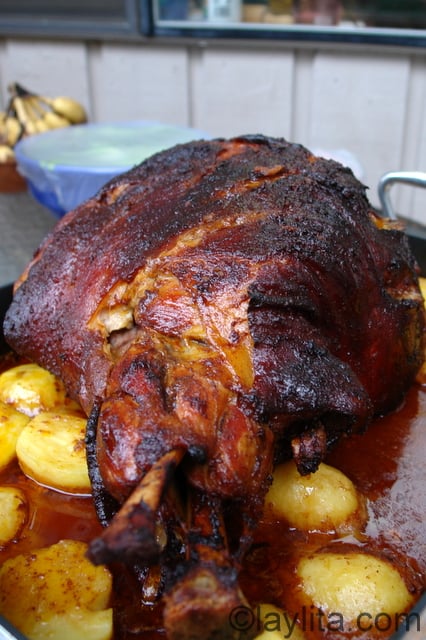
Suggested side dishes for hornado roasted pork:
Step by step preparation photos for Ecuadorian Roasted Pork Leg – Hornado de Chancho
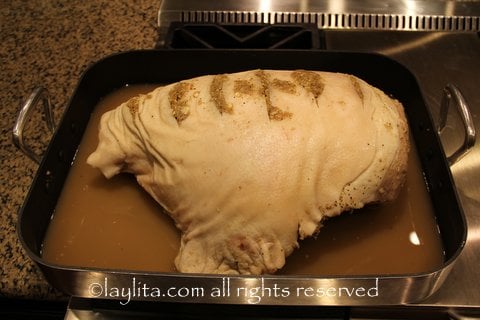
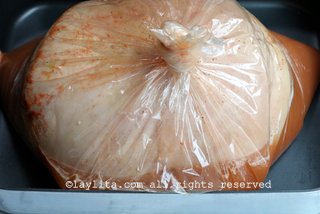
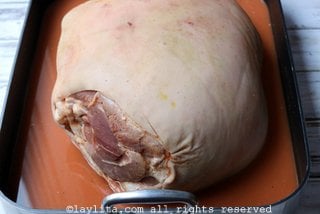
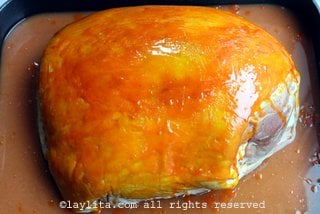
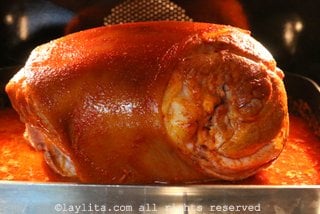
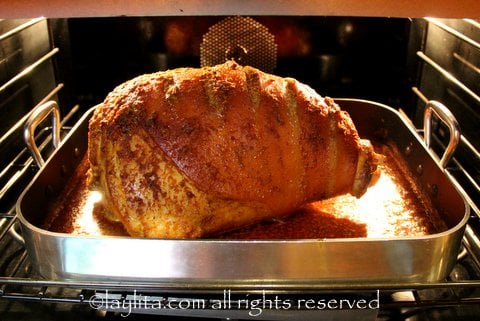
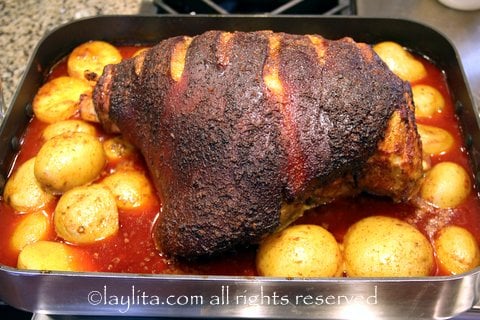
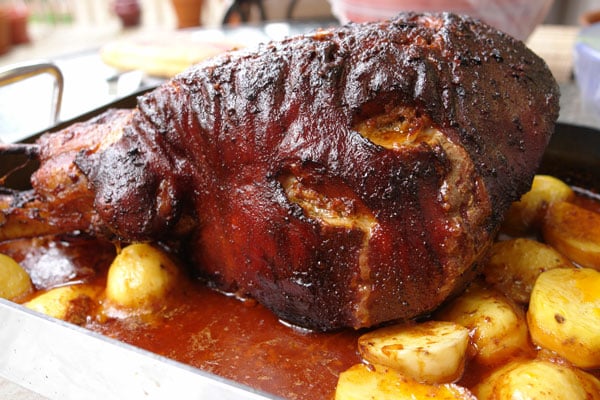
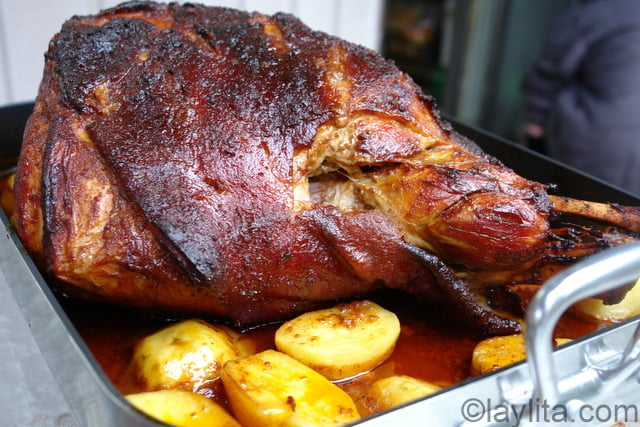
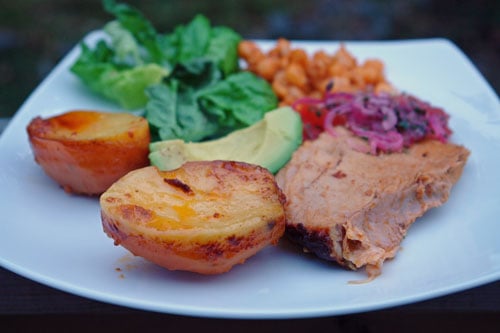
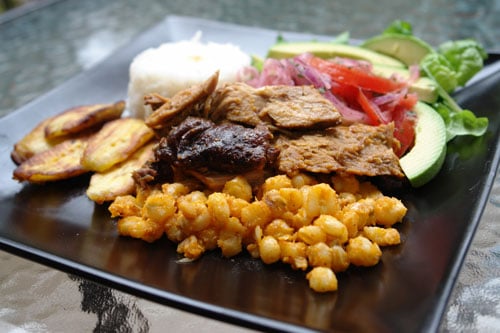
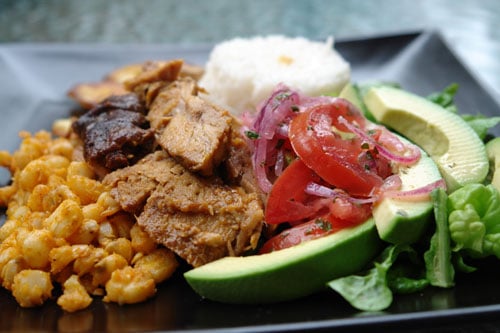
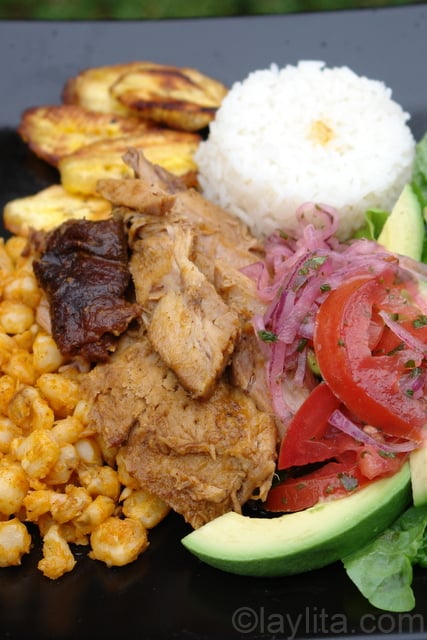
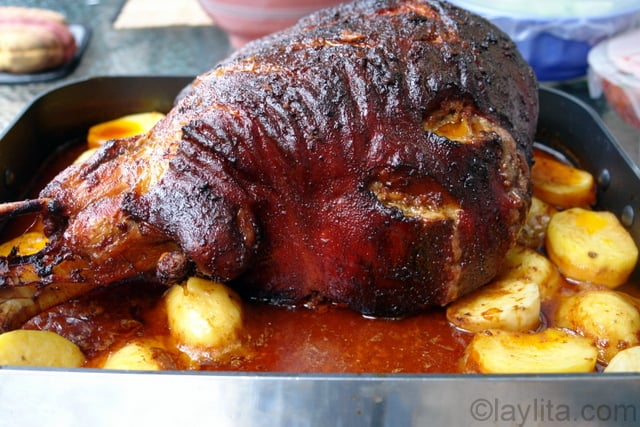
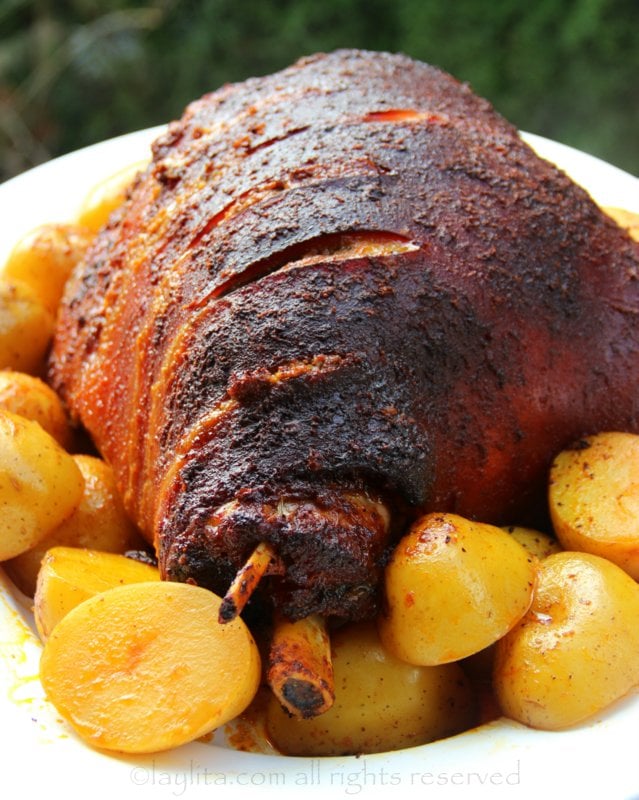
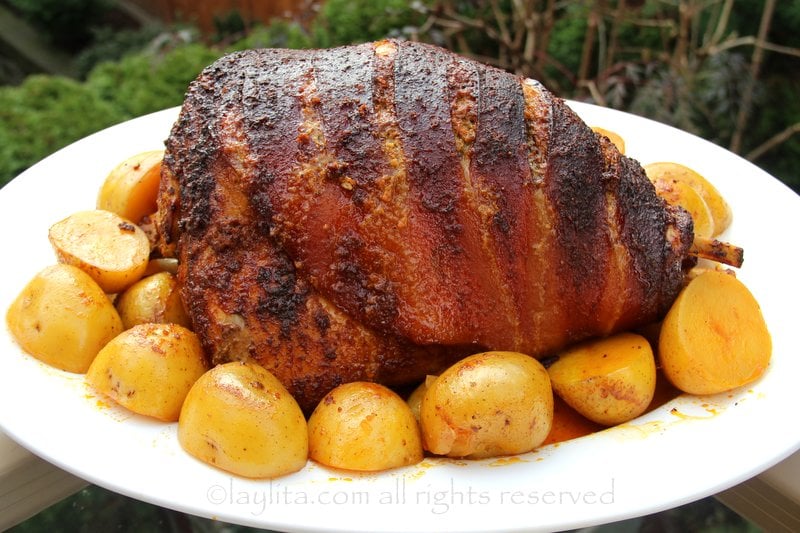
How to butcher a Whole Fresh Leg of Pork at home
FAQ
What to do with a whole pig leg?
What is pork leg good for?
How to cure a whole leg of pork?
Can pork leg be used for pulled pork?
